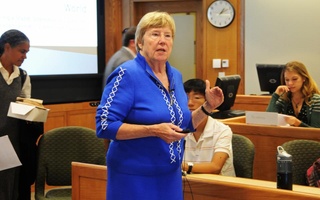Following months of backlash against the announcement that the Q Guide will no longer display course difficulty scores for students, faculty members and undergraduates discussed reevaluating the decision and creating solutions to the problem on Wednesday at the first Committee for Undergraduate Education meeting of the semester.
The group discussed revisiting the decision to hide the difficulty score, changing the difficulty score from a quantitative metric to a more descriptive “narrative,” and publicly displaying grade distribution from previous offerings of a course. According to the Undergraduate Council’s Education Committee chair Dhruv P. Goyal ’16, discussion at the meeting indicated that the decision to change the difficulty display might be revisited by the Faculty Council, the Faculty of Arts and Sciences' governing body.
“The members of the Faculty Council present at the meeting seemed to agree that there was some sort of re-evaluation necessary of this decision,” said Goyal, who noted that he and members of the UC will be presenting a paper with recommendations for the Q score at the next CUE meeting.
The CUE—composed of administrators, members of the Faculty Council, and undergraduates, including UC representatives—is not a legislative body and does not vote on issues discussed. However, matters addressed may be amended at later Faculty Council meetings.
Stephanie H. Kenen, the administrative director of the Program in General Education, said that Dean of Undergraduate Education Jay M. Harris was in favor of adding a narrative element to the difficulty metric to better contextualize the ratings.
“A difficulty score may be more useful when a student knows something more about the background or the context of the student who is rating the course,” Kenen said. “It could be that we ask a narrative question: given your background...how difficult did you find this course?”
However, Kenen said she worried that a narrative explaining a student’s academic background and interests may prove too complicated to create a unified measure of difficulty.
“It’s not consistent in how students would report [the difficulty score without the numerical component] and how anybody would try to filter through that,” Kenen said.
Members of the committee also discussed allowing students to see grade distributions in each of their classes to help them better assess difficulty, though not everyone agreed on the matter.
“A good thing would be that students would know what the grade distribution is going into a course,” said UC representative Brett M. Biebelberg ’16. “The bad thing is that students might see a grade that is otherwise not a bad grade—for example in a course that gives all A’s—and feel that a B or a B-plus is not a good grade, whereas in reality it is.”
—Staff writer Meg P. Bernhard can be reached at meg.bernhard@thecrimson.com. Follow her on Twitter @Meg_Bernhard.
Read more in College News
President’s Challenge To Kick Off MondayRecommended Articles
-
Seniors Petition for Core Class CreditAbout 300 juniors and seniors have petitioned to receive Core credit for departmental courses this year.
-
Conant Prize Recognizes Creative Science ProjectsFor the first time in its over 50-year history, the James Bryant Conant Prize is being awarded to a project consisting of wood, clay, twisted wire, and beams of light rather than a collection of words on a page.
-
 Ed School Offers Gen Ed Course
Ed School Offers Gen Ed Course -
Half of Seniors Chose To Switch to Gen EdThis spring marks the last semester of the College’s Core Curriculum, and the final numbers are in: 56 percent of this year’s seniors have chosen to graduate under the new General Education program.
-
CUE Meeting Talks IntegrityCourse websites and House tutors could become new weapons in Harvard’s fight against academic dishonesty if ideas discussed at Wednesday’s Committee on Undergraduate Education meeting are turned into policy.
-
Few Hit Jackpot In Course LotteriesAs the number of interested students in some already oversubscribed classes continues to grow and Pre-Term Planning data at times fails to accurately predict student interest, professors face the dilemma of how best to accommodate students while still maintaining the quality of their classes.













